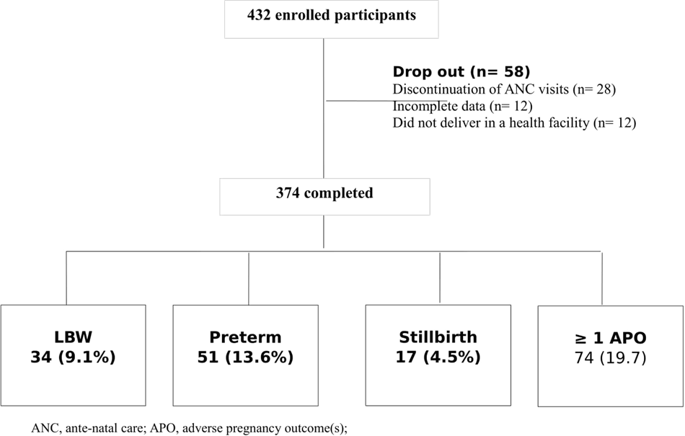Nutrition & Diabetes ( IF 4.6 ) Pub Date : 2018-09-20 , DOI: 10.1038/s41387-018-0060-y Taddese A Zerfu 1, 2 , Elisabete Pinto 3, 4 , Kaleab Baye 5

|
Background
Poor maternal nutrition during pregnancy is a leading modifiable risk factor associated with risks of adverse pregnancy outcomes (APO). Nevertheless, there is paucity of evidence if consumption of some food groups is associated with lower risk of APO, particularly in low-income settings. We aimed to determine whether consumption of some food groups is associated with lower risk of APOs such as: preterm birth (PTB), low-birth weight (LBW), and stillbirth in rural Central Ethiopia.
Methods
A multi-center (8 health centers) prospective cohort study, enrolling 432 pregnant women during their initial antenatal care visit, was employed. All mothers were then followed monthly (for a total of four visits) from enrollment to delivery. Midwives in respective health centers assessed dietary diversity using the Women’s individual dietary diversity score and evaluated birth outcomes following standard procedures. Logistic regression models were run to predict association of food groups with the APO.
Findings
Out of the 374 pregnant women who completed the study, one in five [74 (19.8%)] experienced at least one of the APO: 34 (9.1%) gave birth to LBW babies, 51(13.6%) had PTB and 17 (4.5%) experienced stillbirth. Poor or inconsistent consumption (<¾ assessments) of dark green leafy vegetables (adjusted odds ratio (AOR) = 2.01; 95% confidence interval (CI): 1.04–3.87), dairy products (AOR = 2.64; 95% CI: 1.11–6.30), and fruits and vegetables (AOR = 2.92; 95% CI: 1.49–5.67) were independently associated with higher APO risks. Whereas, being nonanemic at term (AOR = 0.24; 95% CI: 0.12–0.48) was independently associated with lower APO risks.
Conclusions
Poor or inconsistent consumption of dairy, dark green leafy vegetables and fruits were associated with higher risk of APOs. While community-based trials and mechanistic studies are needed to substantiate these findings, efforts to promote dietary diversity through increased consumption of fruits, vegetables and dairy may be beneficial in this and similar settings.
中文翻译:

食用乳制品、水果和深绿叶蔬菜与较低的不良妊娠结局 (APO) 风险相关:埃塞俄比亚农村地区的一项前瞻性队列研究
背景
孕期母亲营养不良是与不良妊娠结局 (APO) 风险相关的主要可改变危险因素。然而,缺乏证据表明食用某些食物组与降低 APO 风险相关,特别是在低收入环境中。我们的目的是确定某些食物组的消费是否与较低的 APO 风险相关,例如:埃塞俄比亚中部农村地区的早产 (PTB)、低出生体重 (LBW) 和死产。
方法
采用了一项多中心(8 个健康中心)前瞻性队列研究,招募了 432 名在初次产前保健就诊的孕妇。然后每月对所有母亲从登记到分娩进行随访(总共四次就诊)。各卫生中心的助产士使用女性个人饮食多样性评分评估饮食多样性,并按照标准程序评估出生结果。运行逻辑回归模型来预测食物组与 APO 的关联。
发现
在完成这项研究的 374 名孕妇中,五分之一 [74 (19.8%)] 经历过至少一种 APO:34 名 (9.1%) 生下了 LBW 婴儿,51 名 (13.6%) 患有 PTB,17 名 (17.0%) 患有 PTB。 4.5%)经历过死产。深绿叶蔬菜(调整后优势比 (AOR) = 2.01;95% 置信区间 (CI):1.04–3.87)、乳制品(AOR = 2.64;95% CI:1.11–)的消费量不佳或不一致(< 3/4 评估) 6.30)、水果和蔬菜(AOR = 2.92;95% CI:1.49–5.67)与较高的 APO 风险独立相关。然而,足月非贫血(AOR = 0.24;95% CI:0.12–0.48)与较低的 APO 风险独立相关。
结论
乳制品、深绿叶蔬菜和水果的摄入不足或不一致与较高的 APO 风险相关。虽然需要基于社区的试验和机制研究来证实这些发现,但通过增加水果、蔬菜和乳制品的消费来促进饮食多样性的努力在这种情况和类似情况下可能是有益的。











































 京公网安备 11010802027423号
京公网安备 11010802027423号